-
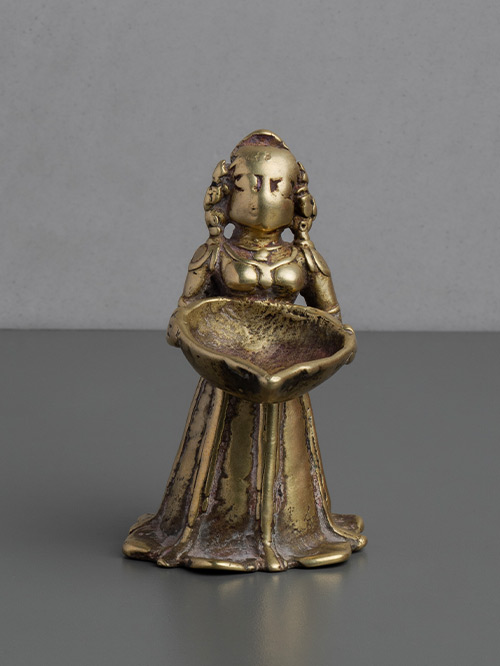

Karnataka
Brass alloy
This attractive and patinated Lakshmi of diminutive proportions stands proudly, holding a deep reservoir burner in her outstretched hands. She wears a long, flowing skirt that touches the floor. Her features, once delicately carved, have been partially worn by years of ritual use. Her hair is tied in a long braid that hangs along her back.
Dipalakshmi or Deepalakshmi is identifiable with Lakshmi, the Goddess of light and wealth. Dipalakshmi is usually shown holding the lamp bowl in her hands cupped in the gesture of anjali or offering of the flame of ‘divine light’ which, when lit kindles light into the image. The lamp is conceived as the vehicle through which the divine can be accessed. Lamps are used in rituals within the domestic realm, as well as religious or temple settings, in order to propitiate the gods.
Size (cms): 9.5(H) x 6(W) x 7.5(D)
Size (inches): 3.5(H) x 2.5(W) x 3(D)
-
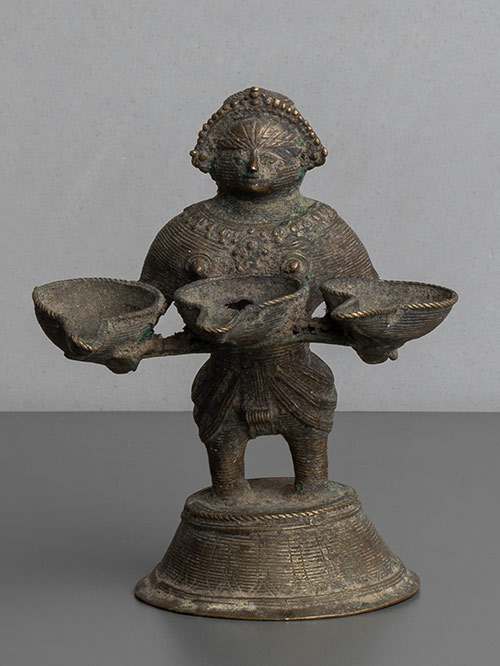
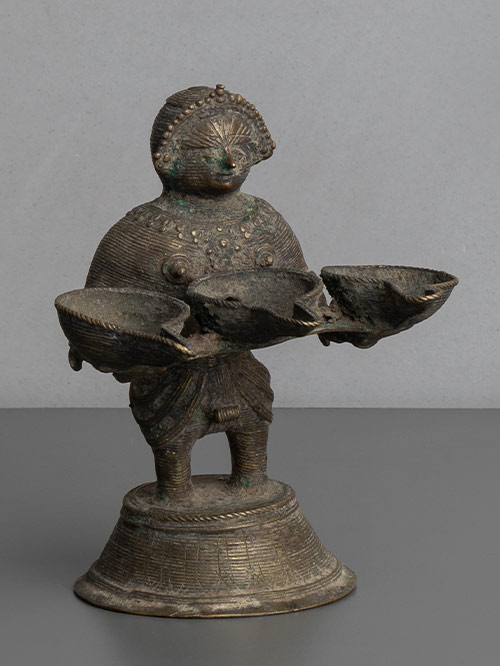
Bastar (Chhattisgarh, Central India)
Brass, Dokra work
An unusual Dipalakshmi lamp from the Bastar region, in the form of a female figure standing holding three teardrop-shaped lamp bowls in her hands. The fine cross-hatching and details are typical of Bastar casting. Dipalakshmi, the Goddess of light and wealth, is usually shown holding the lamp bowl in her hands cupped in the gesture of anjali or offering of the flame of ‘divine light’ which, when lit, kindles light into the image.
Dhokra is non–ferrous metal casting using the lost-wax casting technique. This sort of metal casting has been used in India for over 4,000 years and is still used. One of the earliest known lost wax artefacts is the dancing girl of Mohenjo-Daro. The product of dhokra artisans is in great demand in domestic and foreign markets because of primitive simplicity, enchanting folk motifs and forceful form. Dhokra horses, elephants, peacocks, owls, religious images, measuring bowls, and lamp caskets, etc., are highly appreciated.
Size (cms): 14(H) x 12(W) x 12.5(D)
Size (inches): 5.5(H) x 4.5(W) x 5(D)
-

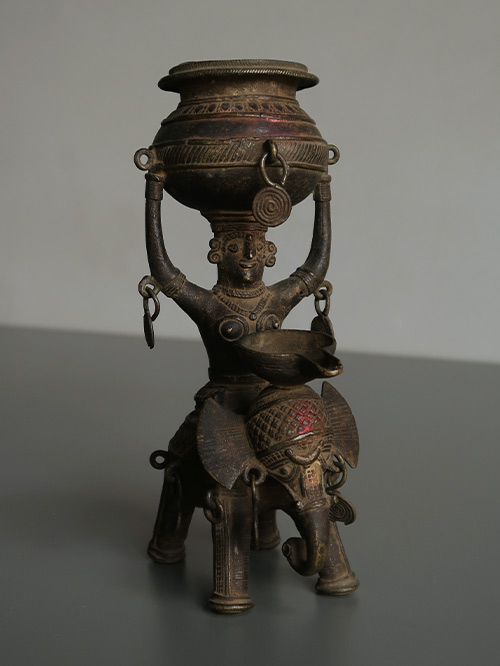
Bastar (Chhattisgarh, Central India)
Brass, Dokra work
An oil lamp depicting Panchdipa, the Goddess of Light who is depicted riding an elephant and bearing a kalasha, or pitcher for oil, on her head. The Goddess and elephant also provide support to a singular oil burner. The fine cross-hatching and details are typical of Bastar casting.
Dhokra is non–ferrous metal casting using the lost-wax casting technique. This sort of metal casting has been used in India for over 4,000 years and is still used. One of the earliest known lost wax artefacts is the dancing girl of Mohenjo-Daro. The product of dhokra artisans is in great demand in domestic and foreign markets because of primitive simplicity, enchanting folk motifs and forceful form. Dhokra horses, elephants, peacocks, owls, religious images, measuring bowls, and lamp caskets, etc., are highly appreciated.
Size (cms): 20(H) x 12.5(W) x 8.3(D)
Size (inches): 8(H) x 5(W) x 3.5(D)
-
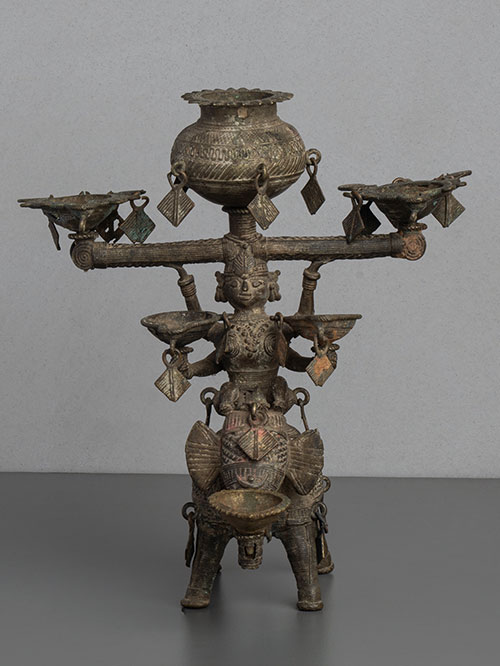
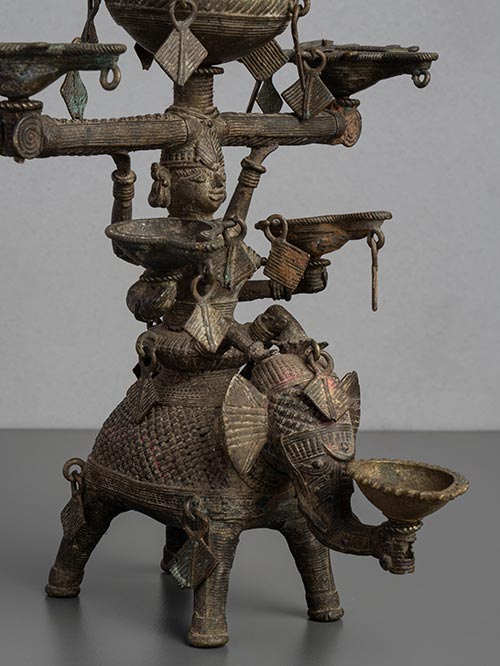
Bastar (Chhattisgarh, Central India)
Brass, Dokra work
An oil lamp depicting Panchdipa, the Goddess of Light who is depicted riding an elephant and bearing a kalasha, or pitcher for oil, on her head. The Goddess also provides support to four oil burners and the elephant holds an additional burner with his trunk. The fine cross-hatching and details are typical of Bastar casting.
Dhokra is non–ferrous metal casting using the lost-wax casting technique. This sort of metal casting has been used in India for over 4,000 years and is still used. One of the earliest known lost wax artefacts is the dancing girl of Mohenjo-Daro. The product of dhokra artisans is in great demand in domestic and foreign markets because of primitive simplicity, enchanting folk motifs and forceful form. Dhokra horses, elephants, peacocks, owls, religious images, measuring bowls, and lamp caskets, etc., are highly appreciated.
Size (cms): 23(H) x 21(W) x 17(D)
Size (inches): 9(H) x 8.5(W) x 6.5(D)
-
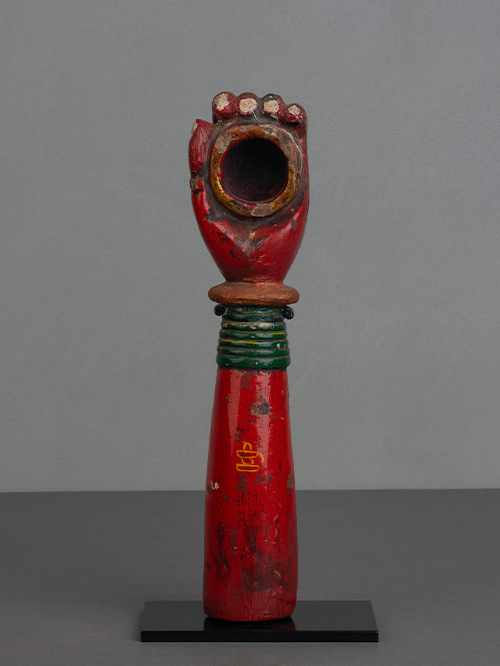
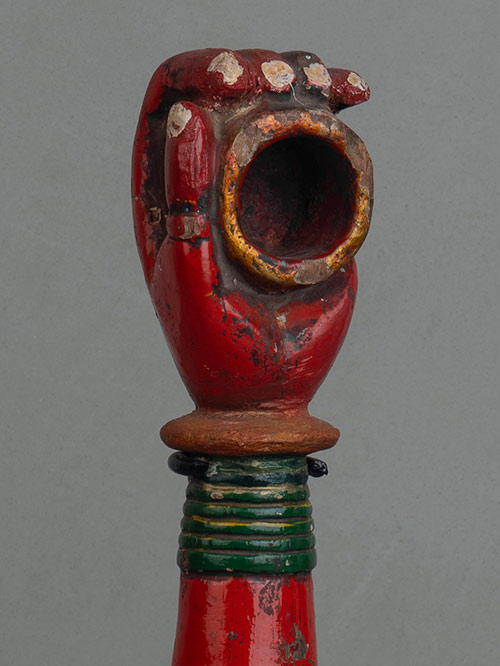
Karnataka
Wood, polychromed
A finely carved wooden hand, with original polychroming wearing bangles. She holds a blood bowl within her clenched fist and a diminutive lingam marks her forearm. Originally from an articulated multi-armed processional figure of a Devi. During festive occasions, the utsavar (portable figures of deities) are placed on chariots or pedestals in the mandapam (audience hall of a temple) or on their respective vahana (vehicle) and taken out for public viewing or darshana. Darshana refers to the occasion where the devotee is not only able to see the image of the deity but also to sense its omnipresence. To enhance the visibility of the utsavar, they are elaborately dressed in dhoti or sari, garlanded with flowers and decked with the most exquisite jewellery, made of gold and semi-precious stones before being brought out in procession. Sometimes additional hands or legs are added to increase the physical presence of the image. These features may allow the deity to stand, sit or clasp multiple weapons.
Size with the Stand (cms):29(H) x 13(W) x 7.5(D)
Size with the Stand (inches): 11.5(H) x 5(W) x 3(D)











